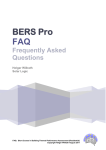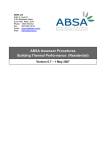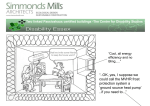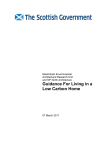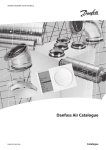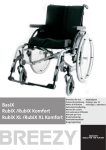Download FORMAL ACTIVITY ANSWERS:
Transcript
SUSTAINABILITY IN ARCHITECTURE: MODULE 2: RESIDENTIAL Pt 1 Thursday 6 June 2013 FORMAL ACTIVITY ANSWERS: 1. What is the “adaptive model” of thermal comfort? The adaptive model is based on the concept that there is a strong relationship between indoor comfort and outdoor climate, taking into account that humans can adapt to and tolerate different temperatures during different times of the year. The adaptive hypothesis predicts that contextual factors and past thermal history modify building occupants' thermal expectations and preferences” Clothing, culture, expectations all play a part 2. Which country builds the worlds biggest houses? Australia 3. List two reasons why house size is critical to achieving sustainability outcomes: Building smaller generally creates a lower ongoing ecological footprint for the rest of that houses usable life, by way of savings in energy (heating, cooling, water use and so on.) Building smaller also reduces the embodied energy of a dwelling, because there is less material involved, but a larger impact over the buildings life is that building smaller also means that the building users will almost certainly have less ‘stuff’ in it. (furniture, electronics, window coverings, appliances, and so on) 4. Relating to designing houses, complete this sentence: Embodied energy of materials is important, but building a low resourceusing house is critical to sustainability performance in the long term. 5. List 6 ‘good design’ or ‘my-grandparent-knows-that’ type-things that all architects design to: -building orientation, -building fabric - thermal performance, -insulation, -glazing, -shading, -thermal mass, -cross ventilation, -infiltration, -efficient appliances -material selection -building ‘zoning’ 6. In achieving sustainability outcomes what’s more important? (circle one) A - the right building or B - the right occupant 7. Define R-Value. ‘Resistance to heat’ – ‘the resistance to heat flow’. Picture in your mind an esky 8. What typical exterior building-enclosing material tends to ‘leak’ the most heat? Glass and glazing 9. What does PCM stand for and what are they? Phase Change Materials. They are materials that change state at a temperature that is useful to assist in minimising heat loads. For extra points: “when PCMs reach the temperature at which they change phase (their melting temperature) they absorb large amounts of heat at an almost constant temperature. The PCM continues to absorb heat without a significant rise in temperature until all the material is transformed to the liquid phase” 10. You are crazy if you don’t use which website (mentioned in this course) as a resource? http://www.designingforclimate.com.au/ 11. Name two non-legislated sustainability tools -NABERS Home, -SEED GreenStar, -any of the multitude of carbon footprint or ‘greenhouse’ calculators, -Living Building Challenge, -One Planet Living, -Passivhaus -taking BASIX beyond the minimum legislated requirements. 12. NatHERs is a rating measured out of how many possible stars? Ten 13. What are the 3 accredited NatHERS (+ ABSA) software tools available for residential? -FirstRate5 -BersPro, -Accurate 14. What will Residential Mandatory Building Disclosure (RMBD) use as its measure? Its important, but nobody knows yet 15. List three things you can do as an architect to lead the behaviour of occupants of your designs? -Tell them what low energy bills you anticipate the house to have and keep in touch with your clients “how is it going?”. -Create a building user manual that is part of your handover ‘pack’. -Positioning power points and switches to make it EASY/encourage switching off behaviour, particularly for certain appliances. -Don’t scrimp on usability items such as remote window winders and the like. -Provide feedback about resource usage. This can be done with 3rd party products or with do-it-yourself affordable systems with paper/screens of data/graphs in prominent place (foyer? kitchen?). -Provide internal doors that allow for sensible building ‘zoning’. -Install web-enabled smart metering as part of the electrical works. 16. What is the ultimate measure of sustainability? Ecological footprint



